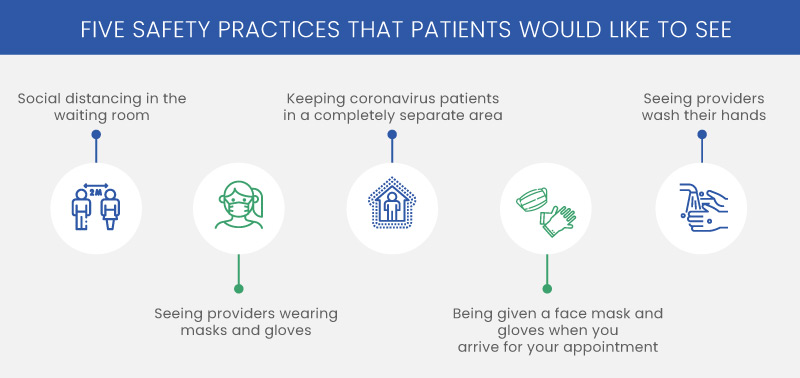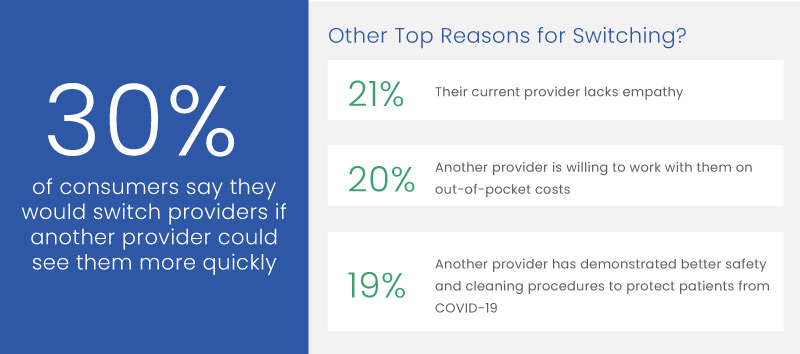5 Strategies to Improve
5 Strategies to Improve Patient Volume during COVID-19

Blog
5 Strategies to Improve Patient Volume during COVID-19

Recent research by the Medical Group Management Association reveals that medical healthcare practices saw a 60% decrease in patient volume since the COVID-19 outbreak.
R ecent research by the Medical Group Management Association reveals that medical healthcare practices saw a 60% decrease in patient volume since the COVID-19 outbreak. This is a result of patients canceling and delaying non-urgent procedures, preventive care, screenings, and follow-up visits. Now that a few states and regions have lifted the shelter-in-home restrictions and as America is reopening healthcare, there has been a steady shift in patients connecting with their care providers. However, there is a general question: will patient volumes post the pandemic return to the pre-pandemic levels?
It’s possible; but not on its own. For doctors to rebuild their patient volume, they would proactively need to leverage their patient engagement solutions and strategies. The post-pandemic scenario requires hospitals, health systems, and medical practices to prioritize patient experience to achieve success and re-engage patients with their care providers. Here are 5 Strategies to improve patient volume post the COVID-19 crisis.
1. Proactive Patient Outreach. In a service industry like healthcare, consumers want to feel important and valued. How can practices act upon this? Talk to your patients and let them know that you have taken all the safety and hygiene measures for your patients to revisit your practice. While making these initiatives, focus on the safety measures that have been taken already than what you intend to do in the upcoming weeks—and what patients can expect when they visit your practice. Practices can also make announcements on their websites and social media pages—and send personalized messages and emails.

2. Provide Appropriate Training for Front-office Staff. The front office staff is more important than ever in helping practices rebuild their patient volume. They are not just scheduling appointments. They are quasi-therapists! The office staff is key to rebuilding patient volume in your practice post the COVID-19 scenario. You need to provide additional training to these staffs on empathic communication as they are most likely to interact with patients who might be going through a post-pandemic trauma. If the office staff doesn’t communicate with patients appropriately during this extreme emotional vulnerability, they are at risk of losing business.
3. Accommodate Patients as Quickly as Possible. Now that patients have delayed care for months, they would not want to wait for weeks or months to get a doctor’s appointment again.

Consider after-hours services, providing weekend hours, offering telemedicine services to meet consumer demands.
JoinDr. is a top-rated telemedicine platform—now available-free of licensing costs, as part of our COVID-19 initiative. Our patient engagement platform is trusted by over 450 hospitals, 3500+ Physicians, and millions of patients worldwide.
4. Embrace a Long-term Virtual Care Strategy. Virtual care has now become the new normal. Practices can attain success by adopting and innovating these technologies quickly. Consider offering teleconsultation services when patients aren’t comfortable visiting the office. Alternatively, patients with a lack of travel facilities, working professionals, and the elderly would also appreciate being offered telehealth services, especially during these uncertain times.
5. Provide Behavioral Health Support. The mental health crisis is at an all-time high, due to the COVID-19 pandemic, and behavioral health support has never been more important. Patients are most likely facing depression, bankruptcy, anxiety in the face of the global crisis. Physicians need to take special initiatives to integrate a behavioral health specialist to offer patients the support they need.
A key takeaway point is that practices can no longer sit and wait for patient volumes to hike up automatically. They were passive means that you are at a high risk of going out of business. Several practices already have. Practices must go out of their way to empower their patient engagement strategies—by offering flexible solutions like telemedicine services and care coordination solutions to drive up their patient volumes.
To learn more on integrating patient engagement and telemedicine solutions in your healthcare organization, talk to our team.
From our humble beginnings as a healthcare start-up—to becoming a full-blown healthcare-exclusive digital transformation provider, our journey has been quite a remarkable one. Today, SolvEdge is a leading-edge Healthcare services and solutions provider—trusted by 450+ Hospitals, 3500+ Physicians and millions of patients across the globe.